KILLER WHALES OF MONTEREY BAY
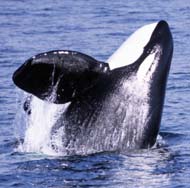
Click on small pictures
to see full-size photos. |
|
National Geographic Explorer
Television Program
focuses on
Monterey Bay Whale Watch
Marine Biologists
Nancy Black and Richard Ternullo
airing on MSNBC Sunday, Nov. 3
at 5 p.m. PT/8 p.m. ET
and 8 p.m. PT/11 p.m. ET
Repeats Saturday, Nov. 9
at 3 p.m. PT/6 p.m. ET |
National Geographic EXPLORER premieres Secret
Killers of Monterey on Sunday, November 3 on MSNBC. Produced by
acclaimed natural history filmmakers Paul and Grace Atkins, the compelling
program focuses on killer whale research conducted by marine biologists
Nancy Black and Richard Ternullo in Monterey Bay, California. Killer whales
are highly intelligent mammals with complex social lives. The "transient"
type of killer whale preys primarily on marine mammals. Hunting prey such
as gray whales, dolphins and sea lions, transients truly exemplify the
killer whale's role as one of the ocean's top predators. The film covers
three years of research on killer whales in the Bay, and includes dramatic
footage of killer whales as well as other whales, dolphins, and other
marine life, illustrating the incredible diversity of animals inhabiting
Monterey Bay.
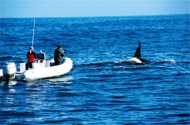 Paul
and Grace Atkins, along with associate producer Anne Marie Hammers, are
award-winning natural history filmmakers. Previous films they produced
for National Geographic Television include Great White Sharks
and Dolphins. For the Monterey Bay project, the film team
worked with Nancy and Richard over a three-year period to document their
research on killer whales. They focused on the spring period when gray
whales and their calves migrate through the Bay and killer whales are
on the hunt for gray whales. Paul
and Grace Atkins, along with associate producer Anne Marie Hammers, are
award-winning natural history filmmakers. Previous films they produced
for National Geographic Television include Great White Sharks
and Dolphins. For the Monterey Bay project, the film team
worked with Nancy and Richard over a three-year period to document their
research on killer whales. They focused on the spring period when gray
whales and their calves migrate through the Bay and killer whales are
on the hunt for gray whales.
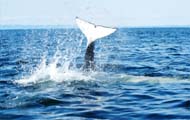 During
the filming years of 1999, 2000, and 2001 the number of gray whale calves
was greatly reduced compared to previous years; however the killer whales
continued their search for the calves as they periodically showed up in
Monterey Bay. The transient killer whales present during the filming period
also hunted elephant seals, harbor seals, California sea lions, Dall's
porpoise, and Pacific white-sided dolphins. In addition, they did attack
several gray whales during the night and the team was able to document
their feeding behavior. During
the filming years of 1999, 2000, and 2001 the number of gray whale calves
was greatly reduced compared to previous years; however the killer whales
continued their search for the calves as they periodically showed up in
Monterey Bay. The transient killer whales present during the filming period
also hunted elephant seals, harbor seals, California sea lions, Dall's
porpoise, and Pacific white-sided dolphins. In addition, they did attack
several gray whales during the night and the team was able to document
their feeding behavior.
The film also includes dramatic video footage, shot by Nancy during 1998,
of killer whales working as a cooperative group with specific roles to
pursue and attack a gray whale calf. For two months each spring season
the researchers and filmmakers went out daily, working under permits on
the 55' Pt Sur Clipper with a towed 22' inflatable. In addition, during
2000 the effort expanded to cover January through October, documenting
seasonal patterns of animals in the Bay. As a National Geographic funded
scientist during that period, Nancy received research grant money for
this effort from both National Geographic Science Grants and National
Geographic Television. This covered some of the research expenses of the
project.
This intense effort produced critical information about the transient
killer whales. Nancy and Richard presented two talks on their work at
the Fourth International Orca Symposium in France during September 2002,
in addition to giving research presentations at the Society for Marine
Mammalogy Biannual Conference in Vancouver, British Columbia in November
2001. An upcoming poster and video presentation will be given at the Defenders
of Wildlife Carnivore Conference November 17-20 in Monterey. The Conference
will also include a presentation by a NOAA toxicologist on the high levels
of PCBs found in killer whales off Monterey compared to levels found in
those in Alaska.
There are at least three ecotypes of killer whales found in the eastern
North Pacific: transients, residents and off-shore. Each type is a distinct
population that differs from the others genetically, behaviorally, and
physically, and all three have been observed in Monterey. They have overlapping
ranges but do not interact or travel together.
Transient killer whales
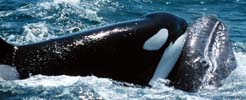 Transients
generally range farther, prey only on marine mammals, live in smaller
groups, and have more pointed fins and saddle patches that differ from
the resident type of killer whale. Transients are the true predators of
the ocean, preying upon seals, seal lions, dolphins, porpoise, and large
whales. A tremendous amount of skill, force, learning, and cooperation
among their group is needed for transient killers to attack these marine
mammals, which are often much larger than themselves. Transients
generally range farther, prey only on marine mammals, live in smaller
groups, and have more pointed fins and saddle patches that differ from
the resident type of killer whale. Transients are the true predators of
the ocean, preying upon seals, seal lions, dolphins, porpoise, and large
whales. A tremendous amount of skill, force, learning, and cooperation
among their group is needed for transient killers to attack these marine
mammals, which are often much larger than themselves.
Black and Ternullo have identified 123 different transient killer whales
in Monterey Bay by their natural markings and have followed their social
and predatory behavior for 15 years. They continue to work with other
killer whale researchers in southern California including
- the Southwest Fisheries Science Center (NMFS/NOAA), which conducts
long-range transect surveys for marine mammals from California to Washington,
- the Center for Whale Research in Friday Harbor, Washington,
- Cascadia Research in Olympia, Washington,
- the National Marine Mammal Laboratory/Alaska Fisheries Science Center/NOAA
in Seattle, WA, which conducts surveys throughout Alaska.
Photo-identification, biopsy samples
and sightings
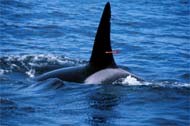 With
funding from the National Oceanographic and Atmospheric Association (NOAA)/
Southwest Fisheries Science Center, Black and Ternullo worked with Alisa
Schulman-Janiger of Los Angeles and Mercedes Guerrero of Mexico to publish
a catalog of photo-identified killer whales for California and Mexico.
They work with the National Marine Mammal Laboratory to collect small
biopsy samples from the whales to analyze DNA for genetic histories and
accumulations of toxic chemicals. Black and Ternullo also collect sighting
information and opportunistic identification whale photos on the daily
whale watching trips they conduct for Monterey Bay Whale Watch. With
funding from the National Oceanographic and Atmospheric Association (NOAA)/
Southwest Fisheries Science Center, Black and Ternullo worked with Alisa
Schulman-Janiger of Los Angeles and Mercedes Guerrero of Mexico to publish
a catalog of photo-identified killer whales for California and Mexico.
They work with the National Marine Mammal Laboratory to collect small
biopsy samples from the whales to analyze DNA for genetic histories and
accumulations of toxic chemicals. Black and Ternullo also collect sighting
information and opportunistic identification whale photos on the daily
whale watching trips they conduct for Monterey Bay Whale Watch.
The biopsy samples collected by Black and co-researchers have revealed
startling results: the real killers of Monterey Bay may not be the killer
whales but the high amounts of toxins found in the blubber. This compelling
research revealed that the transient whales traveling through and feeding
in Monterey Bay contain the highest levels of PCBs known for any marine
mammal worldwide. These persistent chemical compounds are still circulating
through the ocean's food chain and as apex predators, the killer whales
are key indicators of this problem.
Killer whales are found worldwide with a wider distribution than any other
whale or dolphin species, and can be found from the tropics to the polar
regions. Different populations specialize on fish or marine mammals. Scientists
study these whales by first photo-identifying individual whales by nicks
in their dorsal fins and marks in their saddle patches. Association patterns
among the killer whales can be determined from repeated sightings of whale
groups. Killer whales are long-lived animals with males reaching at least
50 years and females 80 years of age; therefore long-term studies are
critical in determining population sizes, reproductive patterns, social
structure and behavioral patterns. Scientists working in different regions
compare photographs of killer whales in their studies and look for matches
between areas, determining home ranges and movement patterns. This works
particularly well in the eastern Pacific from Mexico to Alaska, and Nancy
and Richard work with other scientists who study groups of killer whales
in the Sea of Cortez, Baja California; Los Angeles, California; Puget
Sound, Washington and inland waters of Vancouver Island, Canada; outer
waters of British Columbia and Queen Charlotte Islands, Canada; Southeast
Alaska, Gulf of Alaska and the Aleutian Islands and Bering Sea. Collaboration
among scientists in these regions has produced valuable information that
could not be gathered in any other way.
Resident killer whales
 The most well-known killer whales are the salmon-eating residents
of the Pacific Northwest. Researchers in Friday Harbor, Washington have
studied them for over 25 years and found they live in family groups; even
the males stay with their mothers for life. The three well-known pods
called the southern residents are found around Washington State and Vancouver
Island during the summer months, feeding primarily on Chinook salmon.
Less is known about their winter movements and they appear to range farther
during this period. During January of 2000, marine biologists Nancy Black
and Richard Ternullo identified a group of these resident whales in Monterey
Bay, California. This record is the longest distance documented for these
particular whales. (See February 2000 feature.)
The National Geographic filmmakers working with Black and Ternullo captured
this rare event in their film. Astrid Van Ginniken of the Center for Whale
Research in Friday Harbor sorted through all the photos to identify individual
whales. She found that K and L pods were present in this extraordinary
sighting. The population of southern residents is in decline, which could
be attributed to the high levels of toxic chemicals found in their blubber,
possibly in combination with decreasing salmon numbers. Their travels
to Monterey Bay could be attributed to their search for salmon.
The most well-known killer whales are the salmon-eating residents
of the Pacific Northwest. Researchers in Friday Harbor, Washington have
studied them for over 25 years and found they live in family groups; even
the males stay with their mothers for life. The three well-known pods
called the southern residents are found around Washington State and Vancouver
Island during the summer months, feeding primarily on Chinook salmon.
Less is known about their winter movements and they appear to range farther
during this period. During January of 2000, marine biologists Nancy Black
and Richard Ternullo identified a group of these resident whales in Monterey
Bay, California. This record is the longest distance documented for these
particular whales. (See February 2000 feature.)
The National Geographic filmmakers working with Black and Ternullo captured
this rare event in their film. Astrid Van Ginniken of the Center for Whale
Research in Friday Harbor sorted through all the photos to identify individual
whales. She found that K and L pods were present in this extraordinary
sighting. The population of southern residents is in decline, which could
be attributed to the high levels of toxic chemicals found in their blubber,
possibly in combination with decreasing salmon numbers. Their travels
to Monterey Bay could be attributed to their search for salmon.
Offshore killer whales
The third ecotype of killer whale studied by Black and Ternullo is the
offshore type. These whales look different than residents and transients,
probably prey on fish, squid, and sharks and have the longest range movements
known for any type of killer whale worldwide, ranging over 3600 km. (2200
miles). Little is known about this population which has been sighted during
winter months in Monterey Bay in groups of 100-200 whales spread out over
several miles.
Ongoing Research
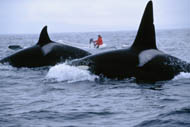 Black
and Ternullo continue to follow the complex social lives, behavior, movements,
genetics and toxic accumulations of chemicals in these nomadic predators.
Their on-going and long-term study of these well-known whales and their
calves is beginning to solve some of the mysteries of one of nature's
most majestic mammals and reveal secrets that could threaten their survival.
Updated reports of their work will be posted periodically on this website.
Nancy is the lead biologist for Monterey Bay Whale Watch and Richard is
the primary captain. You can join them on one of their whale
watching trips, which run nearly year-round. Black
and Ternullo continue to follow the complex social lives, behavior, movements,
genetics and toxic accumulations of chemicals in these nomadic predators.
Their on-going and long-term study of these well-known whales and their
calves is beginning to solve some of the mysteries of one of nature's
most majestic mammals and reveal secrets that could threaten their survival.
Updated reports of their work will be posted periodically on this website.
Nancy is the lead biologist for Monterey Bay Whale Watch and Richard is
the primary captain. You can join them on one of their whale
watching trips, which run nearly year-round.
National Geographic EXPLORER presents Secret Killers of Monterey
on MSNBC on Sunday, November 3, at 5 p.m. and 8 p.m. Pacific Time (8 p.m.
and 11 p.m. Eastern Time). Repeat showing is Saturday, November 9, at
3 p.m. PT (6 p.m. ET). For programming information and updates for National
Geographic EXPLORER, please see www.nationalgeographic.com/tv/explorer.
|
|
![]()
![]()
